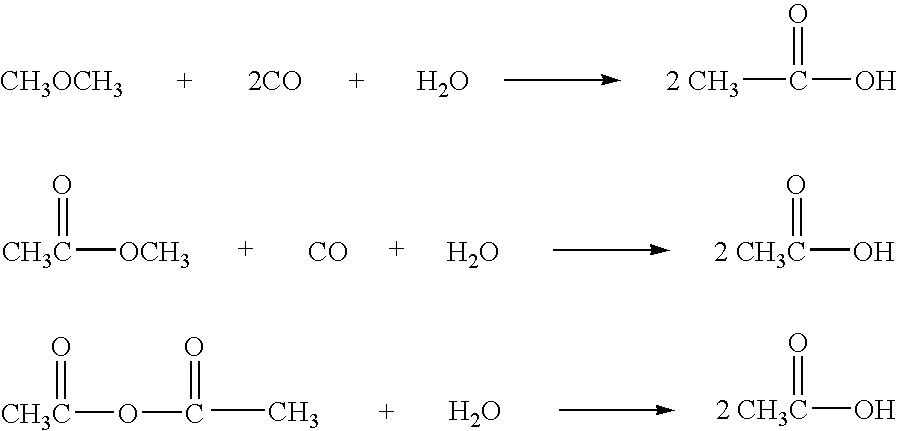Low water methanol carbonylation process for high acetic acid production and for water balance control
a carbonylation process and high acetic acid technology, applied in the field of improved methods for the manufacture of acetic acid, can solve the problems of increasing the capital investment in product recovery and purification equipment, the difficulty in maintaining acceptable high acetic acid production rates, and the tendency of catalyst systems, especially rhodium-based catalysts, to precipitate out of reaction mixtures. high, the effect of high acetic acid production ra
- Summary
- Abstract
- Description
- Claims
- Application Information
AI Technical Summary
Benefits of technology
Problems solved by technology
Method used
Image
Examples
examples
[0039]The Examples set forth in the following Table and related discussion provide exemplary demonstrations of carbonylation reactions in accordance with the present invention in which reaction rates exceed 15 g-mol / l / hr under water concentrations of less than 2.0 wt. %. An experimental unit was employed and brought to a steady state. Conditions are as noted in Table I.
[0040]
TABLE IReaction ConditionsProcess RatesH2OMeOAcMeIRhH2AcidCO2CH4ExampleWt. %wt. %wt. %ppmpsiSTYSTYSTY10.43.76.4161311280.010.0320.55.66.7189712400.010.0130.75.86.1179312360.010.0340.76.06.7138714240.010.021. Reactor conditions for Examples 1–4 are 195° C., 400 psig.2. All STY values provided in g-mol / l / hr.3. All reactions in Examples were at 10 wt. % lithium iodide.
[0041]These Examples demonstrate conditions under which the rate of the methanation reaction exceeds the rate of the water gas shift reaction or the rates are the same. By reviewing the CH4 and CO2 STY's of the Examples, one sees in Example 2, there i...
PUM
| Property | Measurement | Unit |
|---|---|---|
| wt. % | aaaaa | aaaaa |
| wt. % | aaaaa | aaaaa |
| wt. % | aaaaa | aaaaa |
Abstract
Description
Claims
Application Information
 Login to View More
Login to View More - R&D
- Intellectual Property
- Life Sciences
- Materials
- Tech Scout
- Unparalleled Data Quality
- Higher Quality Content
- 60% Fewer Hallucinations
Browse by: Latest US Patents, China's latest patents, Technical Efficacy Thesaurus, Application Domain, Technology Topic, Popular Technical Reports.
© 2025 PatSnap. All rights reserved.Legal|Privacy policy|Modern Slavery Act Transparency Statement|Sitemap|About US| Contact US: help@patsnap.com


